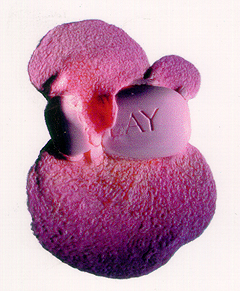|
March 22, 2004
Sesnon Gallery's spring exhibit to feature innovative
works from three UCSC art faculty
By Scott Rappaport
What do exploding soap, the Polaroid I-Zone camera, and an espresso
coffeemaker have in common?
|

E. G. Crichton’s Olay, above; Jimin Lee’s
Transcendant Ordinaire, below; and Norman Locks’ Skull
& Grapes, at bottom, can be found at Faculty Works: 2004,
running from March 31 to May 1 at UCSC’s Sesnon Gallery.


|
They’re all part of Faculty Works: 2004, an exhibition
of innovative photography, video installation, and printmaking that
will be presented by UCSC’s Sesnon Art Gallery from March 31 to
May 1.
The show will feature works by associate professor of art E. G. Crichton,
new assistant professor Jimin Lee, and Art Department chair Norman Locks.
Crichton has blown up dozens of name-brand bars of soap in a microwave
oven for her two-part "Little Disasters" project. These distorted
objects were then scanned or photographed to undergo further transformation
on the computer, eventually ending up as 30- by 40-inch prints. The
series is titled "Spotless."
She said this work is informed by her research on the history of soap
advertising in Britain and the United States, a legacy rooted in promises
to the consumer about racial purity, gender, and upward mobility.
"Starting in the mid-19th century, the ads promised people that
soap would make their skin whiter, help them get the right job, and
boost their marriage prospects," Crichton said. "There's something
very satisfying about exploding these icons of hygiene and purity into
less respectable shapes."
Crichton has so far created about 25 soap images for the "Spotless"
series. She will exhibit three of them at the Sesnon show. Two others
are currently on exhibit at the Center on Contemporary Art in Seattle.
The second part of Crichton's "Little Disasters" will be an
installation of four video loops--one large projection on a wall, and
three on monitors. She noted that the project is a work in progress
that has been markedly influenced by the post-9/11 world.
"I've been staging little acts of destruction in my kitchen,"
she said, “capturing them up close in video. A hammer smashes a
perfect egg, for example, or a meat cleaver cruelly slices a flower."
"When the Oakland fires happened in 1991, I started collecting
ashes from my backyard and burning things in my house such as photos
and papers," Crichton explained. "These became the pages of
an artist book called My Fire. It was part of a process of empathizing
with that disaster, of trying to come to terms with it. Sometimes I
use art to do that--to come to terms with difficult things in life.
‘Little Disasters’ came about that way."
Jimin Lee joined the UCSC art faculty last fall as an assistant professor
specializing in print media. An instructor for the past three years
at the San Francisco Art Institute, Cal State Hayward, and San Francisco
State University, Lee has exhibited at the Palace of the Legion of Honor
in the Bay Area and Anchor Graphics in Chicago, as well as galleries
in Rome, Germany, and Switzerland.
Lee plans to introduce the Santa Cruz community to her recent work,
which combines photo etchings with digital printing. She said her subject
matter consists of everyday objects that are in frequent contact with
her body, including books, an espresso coffeemaker, and a blender.
“This work has developed and slowly evolved from when I was in
graduate school in 1990 at Korea’s Seoul National University,”
Lee noted. “At that time, I only selected objects that touched
my mouth—forks, wineglasses, chopsticks. I was inspired by the
French poststructuralist philosopher Gilles Deleuze.”
Lee employs numerous plates in each of her etchings to heighten the
complexity of the images. “It can sometimes take up to six months
to finish a print,” she said.
“Domestic Landscapes” is the title of art professor and department
chair Norman Locks’s portion of the exhibit. Locks has been scanning
photographs taken with the Polaroid I-Zone camera containing miniature
details of everyday household experiences, and reconstructing them using
digital imaging techniques.
Widely recognized for his experimentation with Polaroids and digital
processes, Locks observed that there are both historical and autobiographical
motivations for his current project.
“It’s probably a throwback to the work I did in the mid and
late ’70s,” he said. “When I was going through undergraduate
and graduate school, I was married with children, so the images that
were important to me were ordinary, domestic household scenes. But 30
years ago I was working on projects using a Polaroid SX-70 camera, and
today I’m using the Polaroid I-Zone--the most recent incarnation
of the Polaroid camera--which was introduced to me by my grandchildren.”
“Another interesting aspect of this project is that I’m linking
an instant, inexpensive camera with a highly technological and expensive
scanner and printer,” he added. “So it’s kind of a low-tech,
high-tech collision as well.”
Locks has taught photography for the past three decades. He joined
the UCSC art faculty in 1977 and has been chair of the department since
1996.
An opening reception will be held at the Sesnon Gallery on Wednesday,
March 31, from 5 to 7 p.m. Each artist in the show will also present
a lecture about his or her work during the month of April--Jimin Lee,
“Transcendant Ordinaire,” April 14; Norman Locks, “Domestic
Landscapes,” April 21; E. G. Crichton, “Little Disasters,”
April 27. The lectures take place in the gallery and begin at 5:15 p.m.
All events are free and open to the public. For more information, go
to: arts.ucsc.edu/sesnon/.
Return to Front Page
|